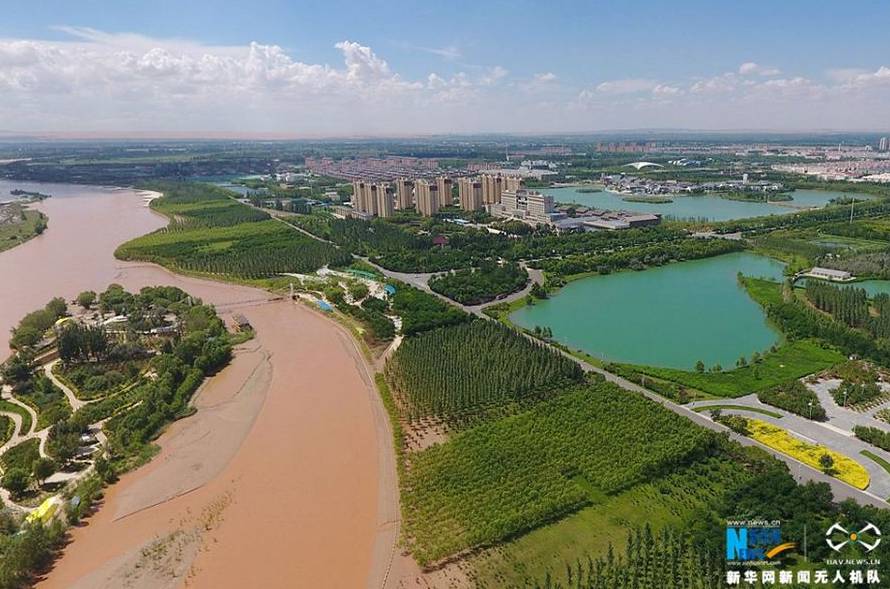

Zhongwei, in northwest China's Ningxia Hui autonomous region, was once a city "shrouded in yellow sands.” However, nowadays the city embraces new opportunities of development, as the local people have planted trees, developed eco-tourism, and introduced high-end industrial chain.

A bird's eye view of Zhongwei. (Photo/Xinhua)
During the harshest period of spring, it is common to see fine sand flying up in the air along with dark skies produced by sandstorms.
Today, Zhongwei is densely planted with trees and a canal runs through the city, resulting from desert control that began as early as the opening of the Baotou-Lanzhou Railway in the late 1950s. At that time, the railway had 55 kilometers across the desert, and since quicksand could bury the track overnight, sand control was imperative.
After years of hard work, sand dunes no longer flow, and plants such as seabuckthorn and scoparium are grown, leaving only 200,000 mu (about 13,333 hectares) of desert in Zhongwei to maintain its original style and develop local tourism characteristics.
Even so, Zhongwei is still making every effort to plant trees. As the vegetation on the barren mountain is fragile, instead of using machinery the local people plant Caragana in the soil by hand before the rain. At this point, the barren mountain has grown 120,000 mu of Caragana.
He Jian, secretary of the Communist Party of China Zhongwei municipal committee, said that in the past ecological protection was mostly about curing the symptoms, but is now moving towards systematic management and ecology, industries and high-quality development have been promoted as an organic whole.
There is a large selenium-rich area on both sides of the Yellow River in Zhongwei. Located high above sea level, the land is dry and cold with fewer pests on fruits and vegetables and fewer diseases among cattle and sheep, which greatly reduces the use of pesticides.
In recent years, soft pears from South Long Beach, dates from North Long Beach, large watermelons from Sandstone Beach, and Chinese wolfberry from Zhongning have all become quite popular on the market.
As the traffic was inconvenient in the past, there were seldom any villagers in Dawan village near the Yellow River. Today, after being re-managed by designers, it has emerged as a popular tourist destination with a cluster of Yellow River-themed hotels.
As cloud computing and cloud storage giants have rushed to Zhongwei, the important city of big data has risen in western China.
In the first half of this year, the added value of information transmission, software and information technology services in Zhongwei increased by 26.4 percent.
 Fire brigade in Shanghai holds group wedding
Fire brigade in Shanghai holds group wedding Tourists enjoy ice sculptures in Datan Town, north China
Tourists enjoy ice sculptures in Datan Town, north China Sunset scenery of Dayan Pagoda in Xi'an
Sunset scenery of Dayan Pagoda in Xi'an Tourists have fun at scenic spot in Nanlong Town, NW China
Tourists have fun at scenic spot in Nanlong Town, NW China Harbin attracts tourists by making best use of ice in winter
Harbin attracts tourists by making best use of ice in winter In pics: FIS Alpine Ski Women's World Cup Slalom
In pics: FIS Alpine Ski Women's World Cup Slalom Black-necked cranes rest at reservoir in Lhunzhub County, Lhasa
Black-necked cranes rest at reservoir in Lhunzhub County, Lhasa China's FAST telescope will be available to foreign scientists in April
China's FAST telescope will be available to foreign scientists in April "She power" plays indispensable role in poverty alleviation
"She power" plays indispensable role in poverty alleviation Top 10 world news events of People's Daily in 2020
Top 10 world news events of People's Daily in 2020 Top 10 China news events of People's Daily in 2020
Top 10 China news events of People's Daily in 2020 Top 10 media buzzwords of 2020
Top 10 media buzzwords of 2020 Year-ender:10 major tourism stories of 2020
Year-ender:10 major tourism stories of 2020 No interference in Venezuelan issues
No interference in Venezuelan issues
 Biz prepares for trade spat
Biz prepares for trade spat
 Broadcasting Continent
Broadcasting Continent Australia wins Chinese CEOs as US loses
Australia wins Chinese CEOs as US loses